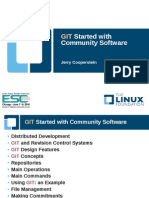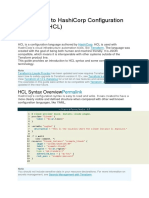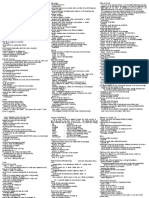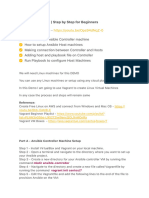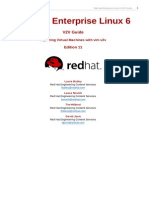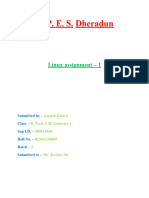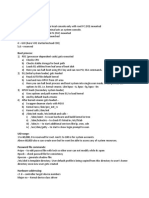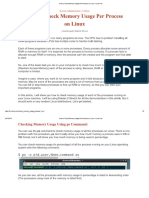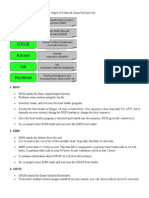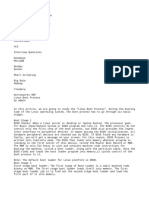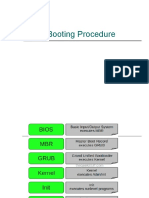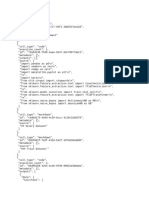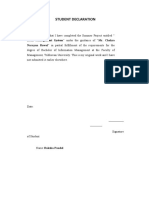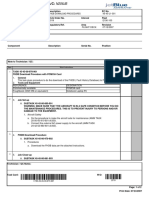1/17/2016 6 Stages of Linux Boot Process (Startup Sequence)
≡ Menu
Home
Free eBook
Start Here
Contact
About
6 Stages of Linux Boot Process (Startup Sequence)
by Ramesh Natarajan on February 7, 2011
165 Like 422 Tweet
Press the power button on your system, and after few moments you see the Linux login prompt.
Have you ever wondered what happens behind the scenes from the time you press the power button until the
Linux login prompt appears?
The following are the 6 high level stages of a typical Linux boot process.
1. BIOS
BIOS stands for Basic Input/Output System
http://www.thegeekstuff.com/2011/02/linux-boot-process/ 1/21
1/17/2016 6 Stages of Linux Boot Process (Startup Sequence)
Performs some system integrity checks
Searches, loads, and executes the boot loader program.
It looks for boot loader in floppy, cdrom, or hard drive. You can press a key (typically F12 of F2, but it
depends on your system) during the BIOS startup to change the boot sequence.
Once the boot loader program is detected and loaded into the memory, BIOS gives the control to it.
So, in simple terms BIOS loads and executes the MBR boot loader.
2. MBR
MBR stands for Master Boot Record.
It is located in the 1st sector of the bootable disk. Typically /dev/hda, or /dev/sda
MBR is less than 512 bytes in size. This has three components 1) primary boot loader info in 1st 446
bytes 2) partition table info in next 64 bytes 3) mbr validation check in last 2 bytes.
It contains information about GRUB (or LILO in old systems).
So, in simple terms MBR loads and executes the GRUB boot loader.
3. GRUB
GRUB stands for Grand Unified Bootloader.
If you have multiple kernel images installed on your system, you can choose which one to be executed.
GRUB displays a splash screen, waits for few seconds, if you don’t enter anything, it loads the default
kernel image as specified in the grub configuration file.
GRUB has the knowledge of the filesystem (the older Linux loader LILO didn’t understand filesystem).
Grub configuration file is /boot/grub/grub.conf (/etc/grub.conf is a link to this). The following is sample
grub.conf of CentOS.
#boot=/dev/sda
default=0
timeout=5
splashimage=(hd0,0)/boot/grub/splash.xpm.gz
hiddenmenu
title CentOS (2.6.18-194.el5PAE)
root (hd0,0)
kernel /boot/vmlinuz-2.6.18-194.el5PAE ro root=LABEL=/
initrd /boot/initrd-2.6.18-194.el5PAE.img
As you notice from the above info, it contains kernel and initrd image.
So, in simple terms GRUB just loads and executes Kernel and initrd images.
4. Kernel
Mounts the root file system as specified in the “root=” in grub.conf
Kernel executes the /sbin/init program
Since init was the 1st program to be executed by Linux Kernel, it has the process id (PID) of 1. Do a ‘ps
ef | grep init’ and check the pid.
initrd stands for Initial RAM Disk.
initrd is used by kernel as temporary root file system until kernel is booted and the real root file system is
mounted. It also contains necessary drivers compiled inside, which helps it to access the hard drive
partitions, and other hardware.
5. Init
Looks at the /etc/inittab file to decide the Linux run level.
Following are the available run levels
0 – halt
1 – Single user mode
2 – Multiuser, without NFS
3 – Full multiuser mode
4 – unused
5 – X11
http://www.thegeekstuff.com/2011/02/linux-boot-process/ 2/21
1/17/2016 6 Stages of Linux Boot Process (Startup Sequence)
6 – reboot
Init identifies the default initlevel from /etc/inittab and uses that to load all appropriate program.
Execute ‘grep initdefault /etc/inittab’ on your system to identify the default run level
If you want to get into trouble, you can set the default run level to 0 or 6. Since you know what 0 and 6
means, probably you might not do that.
Typically you would set the default run level to either 3 or 5.
6. Runlevel programs
When the Linux system is booting up, you might see various services getting started. For example, it
might say “starting sendmail …. OK”. Those are the runlevel programs, executed from the run level
directory as defined by your run level.
Depending on your default init level setting, the system will execute the programs from one of the
following directories.
Run level 0 – /etc/rc.d/rc0.d/
Run level 1 – /etc/rc.d/rc1.d/
Run level 2 – /etc/rc.d/rc2.d/
Run level 3 – /etc/rc.d/rc3.d/
Run level 4 – /etc/rc.d/rc4.d/
Run level 5 – /etc/rc.d/rc5.d/
Run level 6 – /etc/rc.d/rc6.d/
Please note that there are also symbolic links available for these directory under /etc directly. So,
/etc/rc0.d is linked to /etc/rc.d/rc0.d.
Under the /etc/rc.d/rc*.d/ directories, you would see programs that start with S and K.
Programs starts with S are used during startup. S for startup.
Programs starts with K are used during shutdown. K for kill.
There are numbers right next to S and K in the program names. Those are the sequence number in which
the programs should be started or killed.
For example, S12syslog is to start the syslog deamon, which has the sequence number of 12. S80sendmail
is to start the sendmail daemon, which has the sequence number of 80. So, syslog program will be started
before sendmail.
There you have it. That is what happens during the Linux boot process.
165 Tweet Like 422 > Add your comment
If you enjoyed this article, you might also like..
1. 50 Linux Sysadmin Tutorials Awk Introduction – 7 Awk Print Examples
2. 50 Most Frequently Used Linux Commands (With Advanced Sed Substitution Examples
Examples) 8 Essential Vim Editor Navigation
3. Top 25 Best Linux Performance Monitoring and Fundamentals
http://www.thegeekstuff.com/2011/02/linux-boot-process/ 3/21
1/17/2016 6 Stages of Linux Boot Process (Startup Sequence)
Debugging Tools 25 Most Frequently Used Linux IPTables
4. Mommy, I found it! – 15 Practical Linux Find Rules Examples
Command Examples Turbocharge PuTTY with 12 Powerful Add
5. Linux 101 Hacks 2nd Edition eBook Ons
Tagged as: Debian Boot Process, Fedora Boot Process, Linux Kernel Boot Process, Ubuntu Boot Process,
UNIX Boot Process
{ 146 comments… add one }
Pushpraj February 7, 2011, 1:11 am
Excellent……!!! 2011 seems to be rocking for TGS viewers….
Link
BalaC February 7, 2011, 2:53 am
@Ramesh: This is offtopic discussion. Could you write a article on ack. Thanks
Link
shezars February 7, 2011, 4:02 am
you are rock,,, lol
nice,
Link
Adam February 7, 2011, 4:20 am
Great article
You could also write few words about grub2 – configuration files for grub doesn’t work in grub2. (Tested
in ubuntu)
Link
Edward February 7, 2011, 4:30 am
very very nice,
tanx
Link
Ajeya February 7, 2011, 4:58 am
Hello Ramesh,
It would have been better if if you could have explained more on each topic. Probably each high level
boot process would need a separate page.
http://www.thegeekstuff.com/2011/02/linux-boot-process/ 4/21
1/17/2016 6 Stages of Linux Boot Process (Startup Sequence)
This doc is good for begineers.
Thanks,
Ajeya Krishna K R
Link
Abhijeet February 7, 2011, 5:02 am
Good Graphics
Great Tutorial
Keep it up
Link
sagar February 7, 2011, 5:36 am
nice piece of information
thanks lot
Link
sandeep February 7, 2011, 6:38 am
Amazingggggggg good job Guys carry on
Link
jameslee February 7, 2011, 6:56 am
Thank u…
Link
Kuldeep February 7, 2011, 8:09 am
very well explained !!!!!!!!
Thanx alot…..
plz explain GRUB in detail…….How to use GRUB command prompt at system startup ??
Link
Kyle February 7, 2011, 11:02 am
These are very helpful. Keep ’em coming please!
Link
Yogesh Upadhyay February 7, 2011, 1:22 pm
Excellent !!! TGS Rocks…
Link
shanil February 7, 2011, 2:08 pm
thanks alot, just in time to futher clarify things lol..As always, TGS rocks!!!
Link
Júlio Hoffimann Mendes February 7, 2011, 8:15 pm
I learn to much with your blog. Thank you.
Regards,
Júlio.
Link
Steeven Paul Y February 7, 2011, 10:04 pm
http://www.thegeekstuff.com/2011/02/linux-boot-process/ 5/21
1/17/2016 6 Stages of Linux Boot Process (Startup Sequence)
I know the terms GRUB, KERNEL,INIT, MBR. But i do not know how they work together. Thanks to
Ramesh Natarajan, for his blog and useful posts.
Link
Lord February 8, 2011, 12:42 am
Thank you RAMESH. this was so good…
Link
analogtek February 8, 2011, 1:01 am
The file that most would want is. The menu.list that is in the /boot/grub/ directory on my debian system. I
often edit this file for a manual kernel update,time out,boot image change.
Link
Suresh.G February 8, 2011, 2:33 am
Short and Sweet
Link
Sameer Ambekar February 8, 2011, 8:03 am
Really nice document for quick reference to Linux boot process!!!
Link
afujita February 8, 2011, 8:09 pm
Great article, thank you
Link
Renjith G February 10, 2011, 1:45 am
Good one. Thanks.
Link
Mohan February 11, 2011, 10:25 am
plz explain about how to configure zimbra mail server and how to migrate sendmail to zimbra
Link
Roberto February 11, 2011, 6:17 pm
An excelent article, I see another great article here.
Link
Hem Chander March 1, 2011, 2:57 pm
This is very helpful I was looking for similar one..thanks
Link
Pablo March 7, 2011, 10:16 am
Great article Ramesh! But is not completely valid for Ubuntu, which use upstart. Nothing on /etc/inittab,
for eg.
Link
Sameer June 7, 2011, 7:07 am
Good doc.
Thanks
Link
http://www.thegeekstuff.com/2011/02/linux-boot-process/ 6/21
1/17/2016 6 Stages of Linux Boot Process (Startup Sequence)
Verbila June 21, 2011, 5:44 pm
Love this site, your explanations are excellent, and I like how you define terms and acronyms. Sometimes
a man page can make my head spin – your site is the antidote to that – thanks!!
Link
ethaqer July 4, 2011, 8:50 pm
the best explanation ever …
thanks TGS
Link
robin July 7, 2011, 1:30 am
How many times did i ask myself how to find out order of linuxs’ start ?
when this time i saw your blog via TSG, i see thoroughly.
thanks a million
Best Regards
Robin Guo
Link
Senthilkumar July 29, 2011, 12:38 am
Awesome !! For beginners helped a lot..
Link
D VIjay August 11, 2011, 5:48 am
Excellent, in detail and simple. Thanks very much
Link
karthick September 4, 2011, 2:14 am
Actaully i have failed in my first interview for not answering the above question,but after reading the
above answer.i ensure i will get success.its really gud explanation,especially beginners lyk me.Thanks a
lot
Link
dulanja September 19, 2011, 1:11 am
great article! very useful! thanks a lot.
Link
R.YADAV September 30, 2011, 2:52 am
really…….my total confuse remove after read this article.Thank you………….
Link
Gregory October 7, 2011, 2:35 am
Are you sure that “Depending on your default init level setting, the system will execute the programs
from one of the following directories.” ?
For example my system is running on level 3 but executes VERITAS init scripts from rc2.d during the
boot as well.
Link
Arun October 15, 2011, 8:13 am
http://www.thegeekstuff.com/2011/02/linux-boot-process/ 7/21
1/17/2016 6 Stages of Linux Boot Process (Startup Sequence)
Very Nice.
Link
rajesh October 20, 2011, 10:02 pm
Excellent !!!!!!!!!!!!!!!!!!!!!
Enough detail and simple .
Thanks very much
Best regard,
rajesh
Link
ender October 21, 2011, 1:20 am
good work fine to know how linux boot and the basic’s of the init run level’s only by ubuntu you have
init s (single user) and init u (re run init) as extra
Link
evaa November 12, 2011, 9:12 pm
wow, your explaination is simple yet full with information
very helpful ! <3
Link
brijesh November 19, 2011, 2:49 pm
greate usefull
Link
Ketan November 30, 2011, 1:34 pm
I am flabbergasted.. I have made automation on these parts on S and K .,.. It was too Easy to understand
this.. The person who post this.. is really a cool techie.. U rock man..
Link
hossein January 2, 2012, 12:06 am
That was very useful information.
Thanks.
Link
NARESH January 17, 2012, 9:45 pm
Excellent. keep it up..
Link
Arun January 24, 2012, 9:52 pm
Nice. Very useful
Link
Omkar January 27, 2012, 9:32 am
short and sweet and precise explanation
Link
Anonymous February 3, 2012, 3:53 am
very good material and easy to understand …great work
http://www.thegeekstuff.com/2011/02/linux-boot-process/ 8/21
1/17/2016 6 Stages of Linux Boot Process (Startup Sequence)
Link
54nju1 February 19, 2012, 1:59 pm
Thanks dude, that was so helpful..
Link
subhash March 13, 2012, 8:27 am
it’s very nice material…..i like it……..superb ………
Link
sandeep samale March 21, 2012, 9:37 pm
HI this is very very useful information as interview point of view as well as for study how Linux boots.
Great info Thank you very much Ramesh
Link
Anuj April 12, 2012, 9:28 am
Great and brief doc for Linux boot process. I truly liked it!!!
Link
Ravi May 4, 2012, 11:05 pm
Thanx
Link
Deepika May 9, 2012, 11:03 pm
Superb article with detailed information.
Link
Deepak May 14, 2012, 11:11 am
It is very nice article
Link
divya May 21, 2012, 5:19 am
how to create kickstart server in rhel 6.0
Link
sasidharan May 25, 2012, 4:54 am
Excellent stuff from TGS!!!
Link
Anand June 3, 2012, 1:41 pm
gr8 article , got a lot of other info while reading this awesome stuff, thx alot
Link
Sumen June 22, 2012, 5:09 am
Great…very well explained…
Link
VIKAS June 26, 2012, 5:15 am
Very nice, very neatly explained.
Link
http://www.thegeekstuff.com/2011/02/linux-boot-process/ 9/21
1/17/2016 6 Stages of Linux Boot Process (Startup Sequence)
Saravana Kumar July 12, 2012, 2:18 am
Keep on the work going
Link
Kuldeep Kulkarni July 14, 2012, 1:58 pm
Nice Stuff !!
Thanks a lot !!
Link
Rakesh yadav jaipur July 19, 2012, 10:20 pm
really…….my total confuse remove after read this article.Thank you………….
Link
Sudhakar July 26, 2012, 1:14 am
Good One, will be helpfull for new leaners!!!
Link
rajendra July 31, 2012, 8:22 am
excellent
Link
Naveen August 8, 2012, 12:17 am
Its very Good article and helpful for linux beginers
Link
Ranjit Rajput September 10, 2012, 12:57 am
Excellent …
Link
Hughe September 10, 2012, 5:21 am
You can bypass the first three stage using kexec program for fast boot. This saves time when you have to
reboot a lot for tuning system or handling init script.
Debian provides it as kexectools package.
Find the kernel options:
$ cat /proc/cmdline
BOOT_IMAGE=/vmlinuz3.4.010.dmz.1liquorixamd64 root=UUID=07cf8c3ad5a54b41833f
16a9afebf70c ro quiet
Add a kernel image:
vmlinuz is the kernel image file I uses. If the kernel image uses initrd file, add –initrd option. Without it
kernel will panic next boot.
$ sudo kexec l /vmlinuz –append=”root=UUID=07cf8c3ad5a54b41833f16a9afebf70c
ro quiet” –initrd=/initrd.img
Or
In my Linux box, boot partition is /dev/sda1
$ sudo kexec l /vmlinux –append=”root=/dev/sda1 ro quiet” –initrd=/initrd.img
Start warm boot:
http://www.thegeekstuff.com/2011/02/linux-boot-process/ 10/21
1/17/2016 6 Stages of Linux Boot Process (Startup Sequence)
$ sudo kexec e
Linux will boot up without going through BIOS, MBR, and Grub.
Link
manoj sharma September 18, 2012, 9:14 am
thanks
Link
Guru Reddy September 24, 2012, 8:04 am
Excellent.., and thank you a lot..,
Link
karunakar September 27, 2012, 2:22 pm
Excellent and simple explanation and a great deal for beginners !! Thank you.
Link
Rajeev September 28, 2012, 3:23 am
very nice
Link
Mithun Shrivastav October 11, 2012, 3:01 am
Hi its excellent. Thanks.
Link
Amaresh Samal November 13, 2012, 12:34 pm
thanks friend…….
Link
krish November 14, 2012, 2:11 pm
what is 1st stage boot loader and what is 2nd stage boot loader ? kindly clear this point also.
Link
Rajgopal H.G. November 19, 2012, 12:58 am
I am working on Linux since decade. Some times I am unable explain the basic stuff like this. Thanks for
explaining Ramesh Natarajan. Today onwards, I am the member of your fan club.
Link
saurabh December 5, 2012, 2:41 am
Thanks for this excellent article………….
Link
Purna December 18, 2012, 3:26 pm
Hello,
Description is good and very easy to understand, thanks for this.
If possible please explain in detail about each and every config file or script, how is jumping from on
script/configfile to another
Anyways I am happy for this post.
Thank you once more….
http://www.thegeekstuff.com/2011/02/linux-boot-process/ 11/21
1/17/2016 6 Stages of Linux Boot Process (Startup Sequence)
Link
Rajshekhar December 28, 2012, 11:49 am
Excellent material. So simple to understand it. Doing a great job!!!!!
Link
niky December 28, 2012, 1:08 pm
The Article is good And explained Simple …
tnx 4 this
Link
C subhash January 1, 2013, 6:36 am
Thanks for this excellent article……
Link
Amit Bhandari January 18, 2013, 12:31 am
its a superb article……….and simple and superb explanation.
Link
Rajaswaminathan January 24, 2013, 8:33 am
This is really nice article. Appreciate your excellent work.
Link
karthi prasanth February 16, 2013, 7:12 am
sir now i am using windows7 and linux in one computer.i dont want to use linux that have 250gb harddisk
then how to boot(delete) a linux and how to plaace 250gb in windows7? Pls hlp me.
Link
Aswathy February 25, 2013, 11:33 am
Thanks Mr.Linux natarajan
Link
lakshman March 1, 2013, 4:59 am
it was simply good.
Link
prathamesh March 1, 2013, 11:43 am
thanks dude
Link
chrly chacko March 1, 2013, 11:15 pm
good keep itup
Link
Kapil March 20, 2013, 3:46 am
Very Good Explanation.
Thank you very much .
Link
Lily April 4, 2013, 12:36 pm
http://www.thegeekstuff.com/2011/02/linux-boot-process/ 12/21
1/17/2016 6 Stages of Linux Boot Process (Startup Sequence)
Hey,you explained all,excellent.Thanks
Link
Ranjith April 6, 2013, 1:34 am
Thanks Friend
Link
shipra April 13, 2013, 11:51 pm
thnkss ..very useful fo me..;)
Link
Magesh April 16, 2013, 5:29 am
Great Man…..
Link
laks April 19, 2013, 3:13 am
its really useful.
Link
googler April 22, 2013, 2:25 pm
Oh yes .. this is what i am seeking for .. something simple and effective ..
i don’t know why most people who talk about boot process and FHS love to make it
very difficult…
but you my friend .. u r brilliant .. this really easy and useful explanation ..
thanks as enormous as the sky
Link
shruti April 27, 2013, 1:18 am
good explanation & easy to understand!!!
Link
Anonymous May 4, 2013, 12:36 pm
excellent, very well explained
Link
sudhakar May 21, 2013, 11:24 pm
Good article ….
Link
sreejith ks May 26, 2013, 6:01 pm
awesome man, what a simply way to explain such a difficult process.,, thanks a lot,,keep going,,
Link
Mitesh May 30, 2013, 3:22 am
Really Nice Article…. learn much from this…
Thanks
Link
Ashokraj R May 30, 2013, 5:45 am
Thank you
http://www.thegeekstuff.com/2011/02/linux-boot-process/ 13/21
1/17/2016 6 Stages of Linux Boot Process (Startup Sequence)
Link
Akshay June 23, 2013, 12:05 pm
Perfect article on Great topic.
Link
Shams July 20, 2013, 1:19 pm
Ramesh,
Thanks a ton for your efforts to provide such a excellent information by keeping it simple.
You rock man …… Keep it up…
Link
karthik July 25, 2013, 1:32 am
nice job.any one can understand this . good explantion
Link
Suraj August 2, 2013, 1:12 am
Superb Article !!! Excellent explanation.
Keep it on.
Link
Kaali Dasu August 9, 2013, 1:50 am
I got confused by studying the process in another sites however this one is very easy to understand and
remember.
Link
hariharasudhans August 28, 2013, 10:01 am
i have littile bit confusion in bootprocessor .nw i clrd & esay to understand…
good article of boot processor
Link
Arun September 6, 2013, 12:26 am
Thank you for simple, compact and clear explanation . . .
Link
Pradeep September 14, 2013, 7:47 am
Good,Easy to understand and very useful for starters……..:)
Link
yang September 23, 2013, 7:33 pm
good! the article is easy to understand,
Link
Ramesh October 22, 2013, 10:42 am
very nice , thanks
Link
Akshay Kalra October 24, 2013, 11:37 pm
Thanks for such a nice explanation…..
http://www.thegeekstuff.com/2011/02/linux-boot-process/ 14/21
1/17/2016 6 Stages of Linux Boot Process (Startup Sequence)
This article has cleared my all doubts.
Link
montana November 13, 2013, 12:01 am
Simple and Powerful.
Thanks.
Link
Mehbub November 19, 2013, 5:16 am
Thanx a lot for ur great explanations buddy……………………..suprm performance
nw i hv nt any confusn
Link
Pradeep December 13, 2013, 5:14 am
Good work, Thanks
Link
mohammed tousif December 13, 2013, 7:40 am
excellent
Link
Ravi singh December 14, 2013, 2:17 pm
Thanks bro … It is realy excellent and easy to understand
Link
nisha December 27, 2013, 11:34 pm
Thanks for sharing …good article to understand linux boot up process…………………
Link
Narender January 14, 2014, 11:43 pm
that is why lappy takes so much time for startup, actually this guy is busy in doing this or that, offcourse
useful.
Link
Srikanth January 30, 2014, 4:49 am
Thanks a lot. very nice….
Link
viji February 3, 2014, 4:32 am
Thanks much
Link
Satheesh Kumar G February 17, 2014, 12:17 am
Hi Ramesh,
This is the best explanation i’ve seen so far.
ThnQ very much,…
Link
Choperro February 28, 2014, 12:11 am
http://www.thegeekstuff.com/2011/02/linux-boot-process/ 15/21
1/17/2016 6 Stages of Linux Boot Process (Startup Sequence)
The role of initrd is not clear at all.
What does it contain?
Where does it come from?
When and how is it used?
Also the possibilities and methods to configure each step and its pieces are not
clear at all. We can change boot device (interactively or not), we can change the kernel (interactively or
not), we can change the boot menu and give orders to grub….. can we change initrd? how? what for? and
the init proces? inittab seems to be deprecated in Debian…..
Link
Choperro February 28, 2014, 1:43 am
“Programs starts with S are used during startup. S for startup.
Programs starts with K are used during shutdown. K for kill.”
or
The S set are the programs that are started when we enter in that runlevel and K is the set of programs that
are killed when we enter in that runlevel?
Link
Harshit Shrivastava March 12, 2014, 3:56 am
Awesome Tutorial. Linux Boot Process Cleared Very Well.
Link
Gurpreet Singh March 14, 2014, 6:15 am
Excellent Tutorial
Link
Spatik March 26, 2014, 10:18 pm
Nice and well explained, thank you so much.
Link
Syam April 11, 2014, 12:16 am
good one great
Link
Damodhar Taklakar April 18, 2014, 6:34 am
Very well explained….!
Link
venkateswara reddy June 23, 2014, 1:58 am
i’m learning linux admin so any sugences pls give me and any learning text books and any meteriles
Link
priya July 2, 2014, 1:59 am
excellent… very well explained
Link
Rod Nussbaumer July 3, 2014, 9:41 am
The information here all seems correct, however I think you do a disservice to the reader not to mention
that this is just one of many different ways to load Linux on a PC architecture. Other architectures use
http://www.thegeekstuff.com/2011/02/linux-boot-process/ 16/21
1/17/2016 6 Stages of Linux Boot Process (Startup Sequence)
other methods, and there are other methods available on a PC architecture, and the version and
configuration of the Linux kernel itself affects the boot process.
Link
Hal August 5, 2014, 3:08 pm
Thank you for a very clear presentation. I have one small comment, I went looking for the meaning of
“MBR” and “initrd” before reading on to find you gave them later. May I suggest an expansion of the
acronym in brackets immediately after the acronym. Thank you again very well done.
Link
Ancklesh August 30, 2014, 9:16 pm
thanks soo much
Link
Joyneel September 9, 2014, 11:21 am
The best consize and apt explanation i have read so far
Link
Suresh October 7, 2014, 12:29 pm
Very well explained. But latest Ubuntu version 14.04 has some changes with respect to above
explanation.
Link
ashish yadav October 16, 2014, 5:48 am
very nice …… so helpful.
Link
Ashutosh October 31, 2014, 4:11 pm
you are awesome!
Link
dxman November 7, 2014, 2:51 am
Excellent Article Admin – you simplify the words
TFS
Link
Alexlee joana December 8, 2014, 12:42 am
Thanks your good article.
But linux Os (like Cent Os 7) dosen’t have grub.conf.
Please explaing the reason.
Sorry. I am beginner of Linux!
Thanks your favor!
Help me!
Link
jitendra khasdev January 29, 2015, 12:52 pm
MBR is a bootloader ?
Link
nidhi sardeshpande February 4, 2015, 5:33 am
wow!i got too much information which was actually new for me. thank you sooo much.
http://www.thegeekstuff.com/2011/02/linux-boot-process/ 17/21
1/17/2016 6 Stages of Linux Boot Process (Startup Sequence)
Link
rohini rathod February 4, 2015, 5:35 am
nice experience, nice information, thank you so much.
Link
Raj Somwanshi May 24, 2015, 1:03 am
Good one ……Thanks
Link
Harsha Hulikere July 14, 2015, 6:53 pm
Nice and well explained, thanks a lot ..:)
Link
fayaz July 17, 2015, 3:15 am
great one. it has given a simple procedure and best among all..
Link
Sunil January 11, 2016, 2:38 pm
Excellent explaination……
Link
Leave a Comment
Name
Email
Website
Comment
Submit
Notify me of followup comments via email
Next post: UNIX / Linux: 3 Ways to Send Signal to Processes
Previous post: UNIX / Linux: How to Use Sticky Bit on Directory and File
RSS | Email | Twitter | Facebook | Google+
Search
http://www.thegeekstuff.com/2011/02/linux-boot-process/ 18/21
1/17/2016 6 Stages of Linux Boot Process (Startup Sequence)
EBOOKS
Linux 101 Hacks 2nd Edition eBook Practical Examples to Build a Strong Foundation in Linux
Bash 101 Hacks eBook Take Control of Your Bash Command Line and Shell Scripting
Sed and Awk 101 Hacks eBook Enhance Your UNIX / Linux Life with Sed and Awk
Vim 101 Hacks eBook Practical Examples for Becoming Fast and Productive in Vim Editor
Nagios Core 3 eBook Monitor Everything, Be Proactive, and Sleep Well
The Geek Stuff
13,497 likes
Like Page Share
Be the first of your friends to like this
POPULAR POSTS
12 Amazing and Essential Linux Books To Enrich Your Brain and Library
50 UNIX / Linux Sysadmin Tutorials
50 Most Frequently Used UNIX / Linux Commands (With Examples)
How To Be Productive and Get Things Done Using GTD
30 Things To Do When you are Bored and have a Computer
Linux Directory Structure (File System Structure) Explained with Examples
Linux Crontab: 15 Awesome Cron Job Examples
Get a Grip on the Grep! – 15 Practical Grep Command Examples
Unix LS Command: 15 Practical Examples
15 Examples To Master Linux Command Line History
Top 10 Open Source Bug Tracking System
Vi and Vim Macro Tutorial: How To Record and Play
Mommy, I found it! 15 Practical Linux Find Command Examples
15 Awesome Gmail Tips and Tricks
15 Awesome Google Search Tips and Tricks
RAID 0, RAID 1, RAID 5, RAID 10 Explained with Diagrams
Can You Top This? 15 Practical Linux Top Command Examples
Top 5 Best System Monitoring Tools
Top 5 Best Linux OS Distributions
http://www.thegeekstuff.com/2011/02/linux-boot-process/ 19/21
1/17/2016 6 Stages of Linux Boot Process (Startup Sequence)
How To Monitor Remote Linux Host using Nagios 3.0
Awk Introduction Tutorial – 7 Awk Print Examples
How to Backup Linux? 15 rsync Command Examples
The Ultimate Wget Download Guide With 15 Awesome Examples
Top 5 Best Linux Text Editors
Packet Analyzer: 15 TCPDUMP Command Examples
The Ultimate Bash Array Tutorial with 15 Examples
3 Steps to Perform SSH Login Without Password Using sshkeygen & sshcopyid
Unix Sed Tutorial: Advanced Sed Substitution Examples
UNIX / Linux: 10 Netstat Command Examples
The Ultimate Guide for Creating Strong Passwords
6 Steps to Secure Your Home Wireless Network
Turbocharge PuTTY with 12 Powerful AddOns
CATEGORIES
Linux Tutorials
Vim Editor
Sed Scripting
Awk Scripting
Bash Shell Scripting
Nagios Monitoring
OpenSSH
IPTables Firewall
Apache Web Server
MySQL Database
Perl Programming
Google Tutorials
Ubuntu Tutorials
PostgreSQL DB
Hello World Examples
C Programming
C++ Programming
DELL Server Tutorials
Oracle Database
VMware Tutorials
Ramesh Natarajan
Follow
About The Geek Stuff
My name is Ramesh Natarajan. I will be posting instruction guides, howto, troubleshooting
tips and tricks on Linux, database, hardware, security and web. My focus is to write articles that will either
teach you or help you resolve a problem. Read more about Ramesh Natarajan and the blog.
Contact Us
http://www.thegeekstuff.com/2011/02/linux-boot-process/ 20/21
1/17/2016 6 Stages of Linux Boot Process (Startup Sequence)
Email Me : Use this Contact Form to get in touch me with your comments, questions or suggestions about this
site. You can also simply drop me a line to say hello!.
Follow us on Google+
Follow us on Twitter
Become a fan on Facebook
Support Us
Support this blog by purchasing one of my ebooks.
Bash 101 Hacks eBook
Sed and Awk 101 Hacks eBook
Vim 101 Hacks eBook
Nagios Core 3 eBook
Copyright © 2008–2015 Ramesh Natarajan. All rights reserved | Terms of Service
http://www.thegeekstuff.com/2011/02/linux-boot-process/ 21/21


